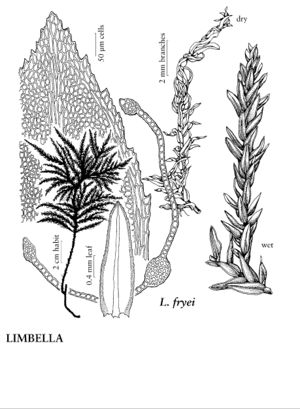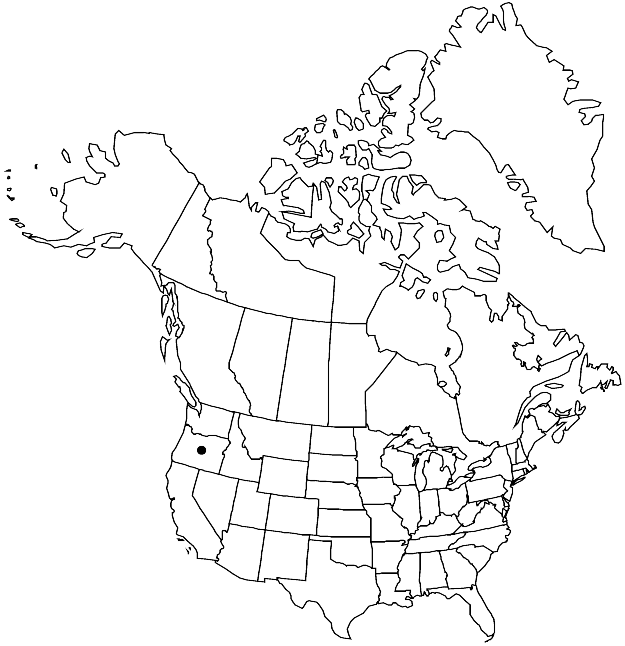Difference between revisions of "Limbella fryei"
J. Hattori Bot. Lab. 61: 313. 1986.
FNA>Volume Importer |
FNA>Volume Importer |
||
| Line 32: | Line 32: | ||
|elevation=low elevations (0-10 m) | |elevation=low elevations (0-10 m) | ||
|distribution=Oreg. | |distribution=Oreg. | ||
| − | |discussion=<p>Limbella fryei is distinguished by its multistratose and serrate margins, lack of paraphyllia, usual dendroid habit, and organic substrate in wetlands. The species bears a superficial resemblance to Climacium dendroides, Leucolepis acanthoneuron, and Pleuroziopsis ruthenica but none of these have the limbidia characteristic of Limbella. For many years, L. fryei was known only from the type locality, a more or less wet pasture, since destroyed by housing development. It is currently known from two small extant populations (J. A. Christy 1980; D. H. Wagner 2009).</p> | + | |discussion=<p><i>Limbella fryei</i> is distinguished by its multistratose and serrate margins, lack of paraphyllia, usual dendroid habit, and organic substrate in wetlands. The species bears a superficial resemblance to <i>Climacium dendroides</i>, <i>Leucolepis</i> acanthoneuron, and <i>Pleuroziopsis ruthenica</i> but none of these have the limbidia characteristic of <i>Limbella</i>. For many years, <i>L. fryei</i> was known only from the type locality, a more or less wet pasture, since destroyed by housing development. It is currently known from two small extant populations (J. A. Christy 1980; D. H. Wagner 2009).</p> |
|tables= | |tables= | ||
|references= | |references= | ||
| Line 55: | Line 55: | ||
|publication year=1986 | |publication year=1986 | ||
|special status=Endemic;Selected by author to be illustrated | |special status=Endemic;Selected by author to be illustrated | ||
| − | |source xml=https://jpend@bitbucket.org/aafc-mbb/fna-data-curation.git/src/ | + | |source xml=https://jpend@bitbucket.org/aafc-mbb/fna-data-curation.git/src/8f726806613d60c220dc4493de13607dd3150896/coarse_grained_fna_xml/V28/V28_496.xml |
|genus=Limbella | |genus=Limbella | ||
|species=Limbella fryei | |species=Limbella fryei | ||
Revision as of 17:06, 18 September 2019
Plants in coarse sods or mats. Stems 4–8(–13) cm, dark reddish brown to black, prostrate or more often dendroid, often defoliate proximally, branches crowded, 1.5–4 cm, arising in clusters from adjacent stem segments, occasionally producing flagelliform branches; pseudoparaphyllia foliose. Stem leaves somewhat contorted when dry, keeled, 1 mm wide, proximal leaves scalelike and erose, distal leaves elongate-triangular to deltoid, plicate, tapering to often subulate, flexuose apex; margins 1-stratose, 1 or 2 cells wide, sometimes forming basal auricles 2–10 cells wide, limbidia usually disappearing near acumen, spurs sometimes extending into lamina, often absent in most proximal leaves; basal laminal cells 7–40 × 5–14 µm. Branch leaves spreading 50–60°, 1.5–3.8 × 1–2 mm; margins serrate in distal 1/3, limbidia strong, disappearing very near acumen, or confluent with costa, to 3.5 mm; basal laminal cells 7–50(–60) × 3–14 µm; distal cells 3–32 × 3–14 µm; leaves on flagelliform branches wide-spreading to squarrose, limbidia absent or poorly developed, 0.4–0.8 × 0.1–0.3 mm. Perichaetia with leaves squarrose, lanceolate, 1.5–2.5 × 0.8–1 mm, margins serrulate distally or entire, limbidia absent, apex long-acuminate, costate. Sporophytes unknown.
Habitat: Mucky peat, decayed wood and bark, coastal shrub swamps
Elevation: low elevations (0-10 m)
Discussion
Limbella fryei is distinguished by its multistratose and serrate margins, lack of paraphyllia, usual dendroid habit, and organic substrate in wetlands. The species bears a superficial resemblance to Climacium dendroides, Leucolepis acanthoneuron, and Pleuroziopsis ruthenica but none of these have the limbidia characteristic of Limbella. For many years, L. fryei was known only from the type locality, a more or less wet pasture, since destroyed by housing development. It is currently known from two small extant populations (J. A. Christy 1980; D. H. Wagner 2009).
Selected References
None.

